By Russ:
The first time I heard this guitar player, I was hooked on his soulful jazzy sound. It was back in 1960 and the tune was called “Sack O’ Woe” (Riverside RLP 12-318), featuring Nat Adderley on trumpet and Wes Montgomery on guitar. I knew nothing about his technique; just that he sounded very cool.
Sack O’ Woe (abridged)
.
To many people, Montgomery’s playing defines jazz guitar and the sound that students try to emulate.
The most immediately obvious of Wes Montgomery’s influences has been the widespread use of octaves by guitarists worldwide, a technique rarely used until popularized by Wes in his early recordings.
You can hear octave playing in everything from the music of Jimi Hendrix, to “elevator music” that wafts through office buildings worldwide, and it all owes a debt to Wes Montgomery.
Wes Montgomery was a very blues-y, lyrical guitarist who made everything he played sound effortless. Many students of jazz guitar still spend hours poring over every facet of Montgomery solos.
Videos:
1965 / The Girl Next Door
.
Round Midnight
.
1965 / West Coast Blues /
Nica’s Dream
Wes Montgomery Live in 1965 (mini documentary 1 hr 18 min.)
Audio:
Cotton Tail / Riverside RLP 382, RS 3036, 12RCD 4408-2 / This tune moves along at an incredible clip; what a thumb!
.
Summertime – Montgomery Brothers / Buddy Montgomery (vib, p) Wes Montgomery (g) Monk Montgomery (b) Billy Hart (d) / “Jorgie’s Jazz Club”, St. Louis, MO / August 19, 1961
.
Stella By Starlight (take 2) / Montgomery Bros / “The Cellar”, Vancouver B.C., Canada / September 16, 1961
.
Delilah (take 4) – Wes Montgomery Quintet / Riverside RLP 407, 12RCD 4408-2 / Milt Jackson (vib) / Wynton Kelly (p) / Wes Montgomery (g) / Sam Jones (b) / Philly Joe Jones (d) /Plaza Sound Studios, NYC / December 18, 1961
.
Canadian Sunset – Wes Montgomery Trio / Riverside RLP 459, 12RCD 4408-2 /Mel Rhyne (org) / Wes Montgomery (g) / Jimmy Cobb (d) / smooth jazz style
.
‘Round Midnight – Wes Montgomery Quintet / Johnny Griffin (tenor sax) Harold Mabern (piano) Wes Montgomery (guitar) Arthur Harper (bass) Jimmy Lovelace (drums) / Live in Paris / “Theatre Des Champs-Elysees” / March 27, 1965
.
An Interview with Wes – Part 1 / 10 min.
.
Interview with Wes – Part 2 / 11 min.
—
Legendary jazz guitarist John Leslie “Wes” Montgomery (March 6, 1923 – June 15, 1968) had a musical life that didn’t follow the traditional pattern of so many other gifted musicians. For example, he never picked up a six-string guitar until he was nearly 20. He had played a four-string tenor guitar since age twelve.
Wes came from a musical family; his brothers, Monk (double bass and electric bass) and Buddy (vibraphone and piano), were jazz performers. The brothers would ultimately release a number of albums together as the Montgomery Brothers.
As his own teacher, Wes was a quick study; he learned by listening to the recordings of his idol, guitarist Charlie Christian. So keen was he, within five years he managed to vault his career into the big league.
Instead of using a guitar pick, Montgomery plucked the strings with the fleshy part of his thumb, using downstrokes for single notes and a combination of upstrokes and downstrokes for chords and octaves.
Montgomery developed this technique not for technical reasons but for his neighbors. He worked long hours as a machinist before his music career began and practiced late at night. To keep neighbors from complaining, he began playing more quietly by using his thumb.
This technique enabled Wes to get a mellow, expressive tone from his guitar. George Benson, in the liner notes of the Ultimate Wes Montgomery album, wrote, “Wes had a corn on his thumb, which gave his sound that point. He would get one sound for the soft parts, and then that point by using the corn. That’s why no one will ever match Wes. And his thumb was double-jointed. He could bend it all the way back to touch his wrist, which he would do to shock people.“
Montgomery generally played a Gibson L-5CES guitar. He used Gibson HiFi Flatwound strings on his guitars going from .058 to .014.
In his early years, Montgomery had a tube amp, often a
Fender Super Reverb with four 10-inch speakers.
In his later years he would play one of two guitars that Gibson custom made for him, and a solid state Standel amp with a 15-inch (380 mm) speaker.
His Career
By July 1948, Montgomery was touring and recording with jazz icon vibraphonist Lionel Hampton. (Wes was known for his ability to play Christian’s solos note for note and was hired by Lionel Hampton for this ability.)
Montgomery toured with Hampton’s orchestra from July 1948 to January 1950.
He then went back home and did not record again until December 1957 (save for one session in 1955), when he took part in a session that included his brothers Monk and Buddy, as well as trumpeter Freddie Hubbard, who made his recording debut with Montgomery.
Most of the recordings made by Montgomery and his brothers from 1957 to 1959 were released on the Pacific Jazz label. Here’s one called Fingerpickin’
.
From 1959 Montgomery was signed to the Riverside Records label, and remained there until late 1963, just before the company went bankrupt. The recordings made during this period are widely considered by fans and jazz historians to be Montgomery’s best and most influential. For example, Yesterdays
.
Two sessions in January 1960 yielded a milestone LP: The Incredible Jazz Guitar of Wes Montgomery
This album was recorded as a quartet with pianist Tommy Flanagan, bassist Percy Heath and drummer Albert “Tootie” Heath. The album featured two of Montgomery’s most well-known compositions, “Four on Six” and “West Coast Blues” (see video above and music chart).
Almost all of Montgomery’s output on Riverside featured the guitarist in a small group setting, usually a trio (and always with his organist from his Indianapolis days, Melvin Rhyne), a quartet, or a quintet, playing a mixture of hard-swinging uptempo jazz numbers and quiet ballads.
Gradual Shift from Jazz
In 1964 Montgomery moved to Verve Records for two years. His stay at Verve yielded a number of albums where he was featured with an orchestra: brass-dominated (Movin’ Wes); string-oriented (Bumpin’, Tequila); or a mix of both (Goin’ Out of My Head, California Dreamin’).
California Dreaming
.
As you can hear, the recording business was shifting Montgomery from jazz to “adult contemporary” music. But he never abandoned jazz entirely in the Verve years, whether with a few selections on most of the Verve albums, or by such sets as 1965’s Smokin’ at the Half Note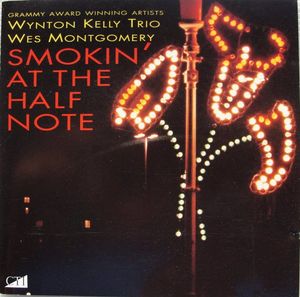
This album showcased two appearances at New York City’s Half Note club with the Wynton Kelly Trio. Here is one of the tunes from that vinyl.
Portrait of Jennie
.
Another pair of Verve albums that he made was with jazz organist Jimmy Smith; Jimmy & Wes The Dynamic Duo and Further Adventures of Jimmy Smith and Wes Montgomery.
Further Adventures of Jimmy Smith and Wes Montgomery / full album
.
As a considered founder of the school of smooth jazz, the album Bumpin’ (1965) represents a model from which many modern recordings are derived.
As the liner notes to the remastered CD say, “ …after being unable to produce the desired results by the guitarist and orchestra playing together, arranger Don Sebesky suggested Montgomery record the chosen music with his chosen small group, after which Sebesky would write the orchestral charts based on what Montgomery’s group had produced.”
The Pop Market
Wes moved on to A&M Records and by the time he released his first album for A&M, he had seemingly abandoned jazz entirely for the more lucrative pop market, though as in his Verve period he continued to play his customary jazz in small group settings in live appearances. This “abandonment” was due to a large extent to the direction of A&M’s producer, Creed Taylor, who could see major potential for success by bringing jazz to the masses.
Three albums released during Montgomery’s A&M period (1967–68) feature orchestral renditions of famous pop songs (“Scarborough Fair”, “I Say a Little Prayer”, “Eleanor Rigby”, etc.) with Montgomery using guitar octave technique to recite the melody. These records were the most commercially successful of his career.
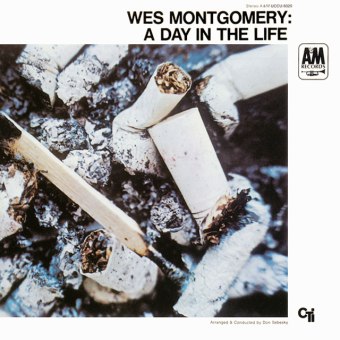
A Day In The Life
.
As Montgomery told the Associated Press in 1968 (after his biggest successes with producer Creed Taylor), he had started his recording career with a focus on pure jazz values; but it evolved into something very different:
“I began by finding things I liked to do and jazz musicians would understand,” he said, but “other people would stare and look with mouth wide open. But I used to feel, this is it; they’ve got to hear it. I was playing for myself for a long time. It was good music, and I recorded it, but it just went to musicians, no further. Then I started to do more melodic things, and I sold more records because the music was more melodic and simplified. And I began to understand that the public will let you know what they want from you by sales.”
His Unexpected Passing
On the morning of June 15, 1968, while at home in Indianapolis, Indiana, Montgomery awoke and remarked to his wife that he “didn’t feel very well.” He soon collapsed, dying of a heart attack within minutes.
Montgomery was a clean man, and never succumbed to the many vices available to jazz musicians, but at only 45 years of age he was no longer with us.
At the time of his death, Montgomery had just returned from a tour with his quintet and was at the height of his fame, having attained a degree of popular acceptance that few jazz artists in that era achieved. Montgomery’s home town of Indianapolis later named a park in his honor.
For the jazz guitarist, he changed the course and direction of jazz guitar evolution and left an unsurpassed musical legacy.
—
Posthumous Release
Echoes of Indiana Avenue (Resonance Records)
THIS nine-tune disc is actually a prequel to the career of celebrated guitarist Wes Montgomery, capturing him in the studio and the easy atmosphere of clubs in his hometown of Indianapolis in 1957 and SSRq58
These recordings would have been made BEFORE his debut Riverside album in 1959 helped propel him to a national audience in the U.S.
The playing is great over eight standards and After Hours Blues, which is just what it says: the kind of late-night jam where you wish you’d been in the audience to hear Montgomery let loose with the guys.
A pair of Monk tunes — Round Midnight and Straight, No Chaser — are terrific, with the guitarist’s subtle playing, especially on Midnight, putting a different spin on the bebop style. The opener, Diablo’s Dance, is a spicy number that gets you moving.
For further information: http://www.allaboutjazz.com/echoes-of-indiana-avenue-wes-montgomery-resonance-records-review-by-dan-bilawsky.php
—
This post has attempted to cover just some of the highlights of Montgomery’s career. For a complete Discography, there are several authoritative sites:
JAZZDISCO.org http://www.jazzdisco.org/wes-montgomery/discography/
Wikipedia.org http://en.wikipedia.org/wiki/Wes_Montgomery_discography
–o–


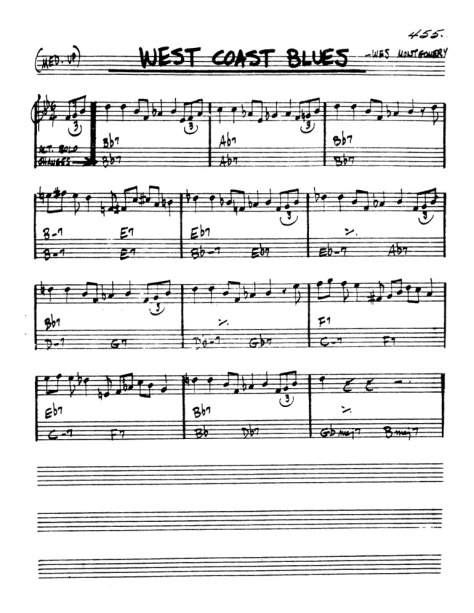
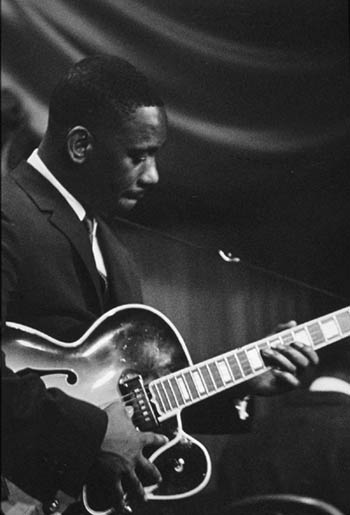

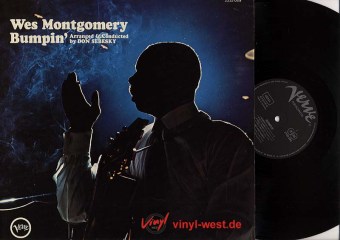
Russ and Gary, of all your posts, which are always really good (i.e., enriching to my musical mind), this is my favorite!! Montogomery, to me as a (aspiring) guitarist, is in the pantheon of jazz immortals, right there with Charlie Christian, Django Reinhardt, Joe Pass, Tal Farlow, and so on. Also, I think I emailed either Russ or Gary my brief research paper about bepop jazz last year, and I’m wondering, did you ever recieve it and/or take a glance? Thanks again for always sharing a wide variety of music with us, once again!
LikeLike